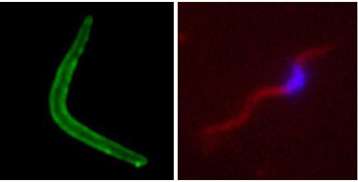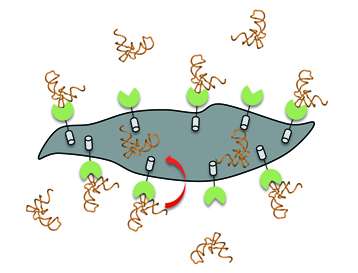Malaria—a new route of access to the heart of the parasite

Scientists have just identified an Achilles heel in the parasite that causes malaria, by showing that its optimum development is dependent on its ability to expropriate RNA molecules in infected cells – a host-pathogen interaction that had never previously been observed. Although the precise function of this deviation remains mysterious, these findings open new perspectives for the targeted delivery of therapeutic agents within the parasite. This study, performed by the CNRS Architecture et Réactivité de l'ARN laboratory (Strasbourg), in collaboration with the Malaria Infection and Immunity Unit at Institut Pasteur (Paris), is published in PNAS the week of 11 April 2016.
Single-cell parasites in the Plasmodium genus are the infective agents responsible for malaria and constitute one of the principal threats to human health and development in southern hemisphere countries. The life cycle of this parasite occurs partly in the Anopheles mosquito (digestive tract, salivary glands) and partly in humans or other mammals (liver, blood cells).
During this study, the biologists identified a protein (tRip) localized on the parasite's surface and capable of of importing host tRNA into the parasite (tRNAs are key molecules involved in protein production). This is the first time that the import into cells of exogenous tRNA has been demonstrated. The scientists also demonstrated that if tRip were not present, the parasite no longer imported tRNA, its protein synthesis was reduced, and its development was markedly slowed down in the blood cells of infected mice.

But what is the function of this tRNA expropriation by Plasmodium? While most eukaryote genomes contain several copies of each tRNA gene, the Plasmodium genome codes for a minimum number of these genes. Thus the parasite may need supplementary tRNA to complete the synthesis of the proteins necessary for its development. According to another hypothesis, host tRNA may act as small regulatory RNA and modulate expression of the parasite's genes.
From a medical point of view, the discovery of this mechanism means that it may be possible to develop methods to enable the targeted entry of therapeutic molecules into the parasite, so as to improve the efficacy of treatments. Particularly since the tRip protein – and thus, perhaps, this import mechanism – is seen in other parasites in the Plasmodium family, the Apicomplexa, which include the human pathogens Toxoplasma and Cryptosporidium.
More information: Tania Bour et al. -specific tRip facilitates import of exogenous tRNAs into malaria parasites , Proceedings of the National Academy of Sciences (2016). DOI: 10.1073/pnas.1600476113
Journal information: Proceedings of the National Academy of Sciences
Provided by CNRS




















